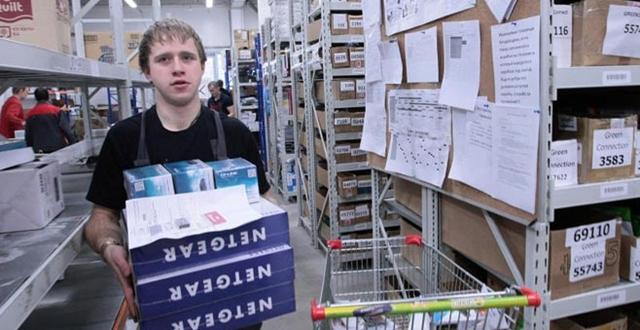On October 19th, at the 2023 Ozon Global China Summit and "Belt and Road" E-commerce Development Forum held in Hangzhou, Zhejiang Province, the conference hall, which can accommodate more than 1,000 guests, was filled to capacity. The check-in hall outside the conference hall was also filled with participants coming to negotiate and exchange ideas.
This is the second time that Ozon Global has organized a summit in China. At the conference, Stepan Gusamov, CEO of Ozon Global and head of Ozon's cross-border division, told China Trade News that by 2022, Russian consumers will spend $84 billion online, with about 72 million online consumers, more than half of whom will spend more than once a year on the Ozon platform.
According to Stepan Gusamov, in 2016, the e-commerce penetration of the Russian market was still only 5%, and by now this number has grown to 17.2%. He believes that by 2027 the e-commerce penetration of the Russian market will be as high as 32%. "In 2019, Russian consumers on average purchased goods online only once a quarter. But today, they spend more than 17 times online throughout the year." And among the many consumer goods, the non-food segment is expected to dominate the online e-commerce channel. "We are already seeing growth in online transactions in this segment of 40 to 50 percent."

Stepan Gusamov says that in 2022, there will already be two e-commerce platform companies, including Ozon, among the top five retailers on the Russian market. In the past, about half of all online merchandise transactions in Russia took place within e-commerce platforms. Today, however, this percentage is over 70%. Against this backdrop, Ozon's annual sales in 2023 are expected to reach 1.5 trillion rubles (about $180 billion). This is a numerical increase of more than 34 times compared to 2017. As of today, Ozon has become one of the most important e-commerce brands in Russia.
The cross-border e-commerce foundation between the two countries continues to improve
Behind the numbers, more and more offline pickup points for e-commerce platforms are rapidly springing up in Russia. Stepan Gusamov said, "Currently, the top three e-commerce marketplaces in the Russian market have more than 70,000 offline pickup points, of which 40,000 are owned by Ozon."
The growing online sales in the Russian market have also allowed more Chinese companies to see business opportunities. As of this year, the Ozon platform has attracted more than 40,000 Chinese sellers to participate in sales. The company plans to increase that number to more than 100,000 by the end of 2024.
In order to attract more local Chinese sellers, in November 2022, Ozon Global opened a corporate representative office in Shenzhen, Guangdong Province, China.
As Russia's largest local integrated e-commerce listed company, Ozon is also planning to set up a branch in East China, in addition to establishing its South China headquarters in Shenzhen, China, said Huang Xing, executive general manager of Ozon Global China, in an interview.
In recent years, economic and trade exchanges between China and Russia have been deepening.2022, the bilateral trade volume between China and Russia reached a record 190.271 billion U.S. dollars, a year-on-year increase of 29.3 percent. Among them, China exported 76.123 billion U.S. dollars to Russia, up 12.8% year-on-year; China imported 114.149 billion U.S. dollars from Russia, up 43.4% year-on-year. In terms of scale, China-Russia trade maintained steady growth in 2022. The share of China-Russia trade in China's foreign trade increased by 0.9 percentage points from 2.4% in 2021 to 3.3% in 2022. China has held its position as Russia's top trading partner country for 13 consecutive years.
Along with the growing trade in goods between China and Russia, the demand for logistics services from enterprises in the two countries is also increasing day by day. However, in the past, the transportation of goods between China and Russia was often criticized by enterprises because of the logistics timeframe and other reasons.
In order to meet the growing consumer demand, Ozon is also working hard to improve its own logistics services. Huang effect introduced: "At present, we are working with China Post, Jingdong Logistics and other enterprises to continue to create faster and more efficient logistics and warehousing solutions."
In March 2022, Ozon Global launched partner logistics from China to Russia, shortening the delivery time by two times. in December 2022, Ozon Global also cooperated with China Post to open Ozon ePostBao and Ozon ePostBao Special Offer. From April 2023, Ozon sellers can send goods to buyers at 700 China Post outlets. In addition, Russian buyers can receive goods from China at any of their domestic pickup points. And in the near future, Ozon Global will also launch partner warehousing centers for Chinese entrepreneurs.Ozon plans to reduce the delivery time from China to Russia to 8 to 12 days.
"Silk Road E-commerce" has a long term meaning
In fact, the potential for cross-border e-commerce cooperation between China and Russia extends far beyond the Russian market.

Seeing that the annual "Double Eleven" shopping festival on China's e-commerce platform is approaching, Ozon has also begun to vigorously promote related promotions in Russia and Kazakhstan. "At present, 'Double Eleven' has become the highest-selling e-commerce trading day of the year in Russia and Kazakhstan," Huang said. Huang effect introduced.
October 23, the Chinese government network officially announced "the State Council on the creation of" Silk Road Electricity "in Shanghai, the approval of the pilot program of cooperation". According to the approval, the "Silk Road E-commerce" cooperation zone will dock the international high standard economic and trade rules, explore institutional mechanism innovation, expand the opening up of e-commerce, create a new high ground for international cooperation in the digital economy, and play an important role in the high-quality development of the service of building the "One Belt, One Road". Play an important role in serving the high-quality development of the "Belt and Road".
Previously, Guo Tingting, Vice Minister of Commerce, revealed that in 2022, the total trade in goods between China and the "Belt and Road" countries will be close to 2.9 trillion U.S. dollars, accounting for about 45% of the total foreign trade, with a year-on-year growth rate of 12.4%, which is higher than the overall growth rate of China's foreign trade by about 8 percentage points. In the most recent edition of the Canton Fair, buyers from the "Belt and Road" countries are expected to reach 80,000 people. Over the past 10 years, on the Canton Fair platform, the proportion of overseas buyers from countries along the "Belt and Road" has risen from 50.4 percent to 58.1 percent.
The latest data from the General Administration of Customs shows that in the first three quarters of this year, China's import and export to countries along the "Belt and Road" is 14.32 trillion yuan, an increase of 3.1% year-on-year, accounting for 46.5% of China's foreign trade. Specifically, China's import and export to Central Asia, Africa, Latin America and other emerging markets grew by 33.7%, 6.7% and 5.1% respectively, which are higher than the overall growth rate of China's foreign trade.
Xu Po Ling, director of the Economic Office of the Institute of Russian East European and Central Asian Studies of the Chinese Academy of Social Sciences, said that retail transactions on e-commerce platforms have maintained growth in the face of slowing or even stagnant growth in global consumption and commercial retail. Among them, "Silk Road e-commerce" is the main force, mainly in Eastern Europe and Russia, which also brings opportunities for Chinese enterprises.
In terms of "Silk Road E-commerce", Ozon is now operating in Kazakhstan, Kyrgyzstan, Armenia and Belarus, Huang said. In addition, Ozon is also working hard to promote the construction of various infrastructures in Central Asia, and continue to carry out market cultivation in the above region. "In the future, this will be a medium- to long-term plan."

